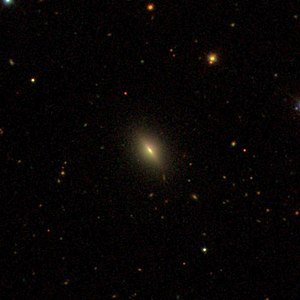IC 705
| Galaxy IC 705 |
|
|---|---|

|
|
| SDSS recording | |
| AladinLite | |
| Constellation | Big Bear |
|
Position equinox : J2000.0 , epoch : J2000.0 |
|
| Right ascension | 11 h 32 m 56.3 s |
| declination | + 50 ° 14 ′ 31 ″ |
| Appearance | |
| Morphological type | C. |
| Brightness (visual) | 14.5 mag |
| Brightness (B-band) | 15.5 mag |
| Angular expansion | 0.80 × 0.4 |
| Position angle | 27 ° |
| Surface brightness | 13.1 mag / arcmin² |
| Physical data | |
| Redshift | 0.009828 ± 0.000141 |
| Radial velocity | 2946 ± 42 km / s |
|
Stroke distance v rad / H 0 |
(134 ± 9) x 10 6 ly (41.1 ± 2.9) Mpc |
| history | |
| discovery | Lewis Swift |
| Discovery date | May 11, 1890 |
| Catalog names | |
| IC 705 • PGC 35644 • CGCG 268-050 • MCG + 08-21-049 • 2MASX J11325631 + 5014310 • GALEX ASC J113256.24 + 501429.7 | |
IC 705 is a compact galaxy of Hubble type C in the constellation Ursa Major at the northern sky . It is estimated to be 134 million light-years from the Milky Way and about 30,000 light-years across .
The Type I supernova SN 1997bm was observed here.
The object was discovered by Lewis Swift on May 11, 1890 .
